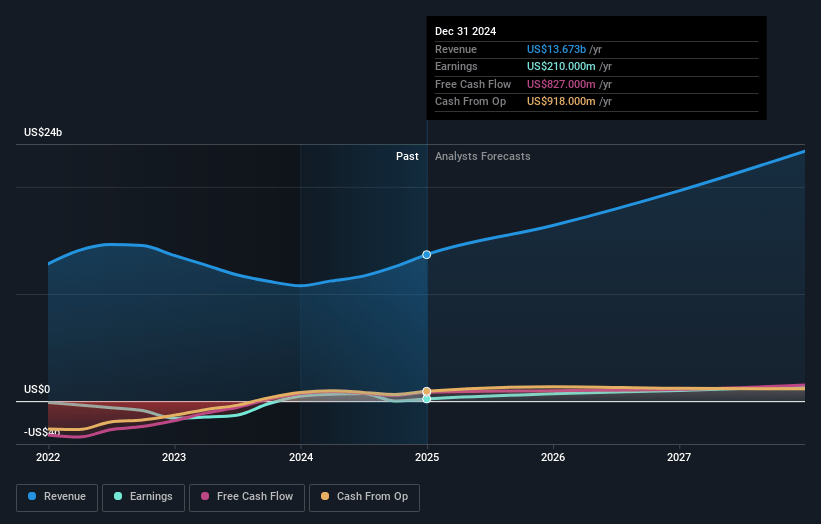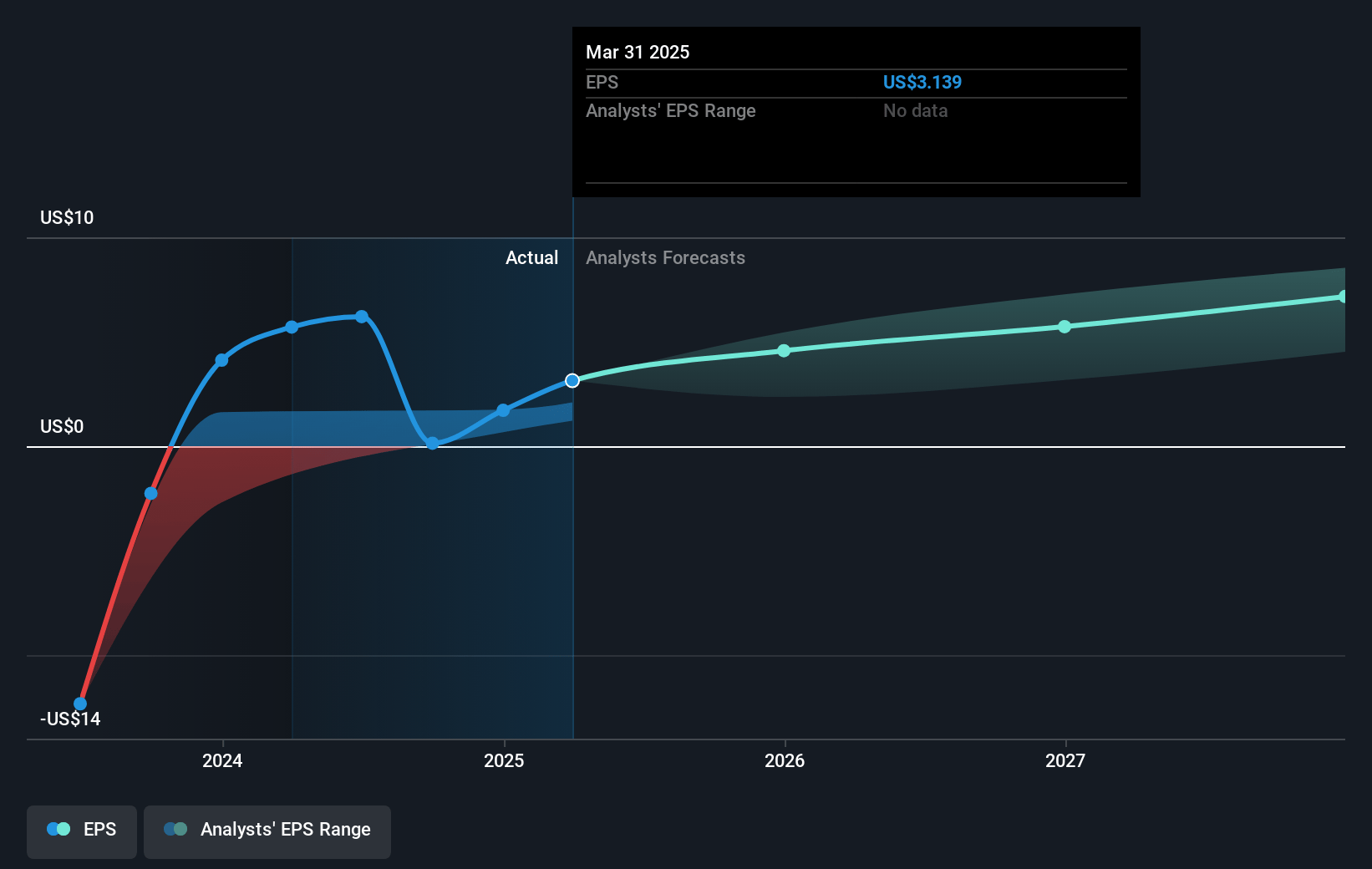Key Takeaways
- Expansion of reconditioning capacity and cost efficiencies may drive revenue growth and margin improvement for Carvana.
- Focus on customer experience, brand awareness, and AI integration could boost sales and enhance operational efficiency.
- Carvana faces challenges related to scaling operations, competitive market dynamics, logistics efficiency, high debt levels, and integration of ADESA sites, affecting margins and profitability.
Catalysts
About Carvana- Operates an e-commerce platform for buying and selling used cars in the United States.
- The integration of ADESA mega sites is expected to expand Carvana's reconditioning capacity significantly, which could enable scale efficiencies and support revenue growth by increasing the volume of cars processed and sold.
- Carvana's rigorous operational efficiency initiatives have driven a reduction in costs such as reconditioning and inbound transport, which could enhance net margins over time as these cost improvements are scaled.
- A focus on continuously enhancing customer experiences and increasing brand awareness is anticipated to drive higher conversion rates and boost revenue, as customer satisfaction and brand familiarity lead to increased sales.
- The adoption and integration of AI technologies to improve customer experience and operational efficiency may drive incremental revenue growth and margin expansion by optimizing inventory management and streamlining processes.
- Continued deleveraging and improved credit metrics provide financial stability and flexibility, potentially leading to lower interest expenses and improved earnings over time.
Carvana Future Earnings and Revenue Growth
Assumptions
How have these above catalysts been quantified?- Analysts are assuming Carvana's revenue will grow by 19.8% annually over the next 3 years.
- Analysts assume that profit margins will increase from 1.5% today to 5.8% in 3 years time.
- Analysts expect earnings to reach $1.4 billion (and earnings per share of $6.25) by about April 2028, up from $210.0 million today. However, there is a considerable amount of disagreement amongst the analysts with the most bullish expecting $1.8 billion in earnings, and the most bearish expecting $693 million.
- In order for the above numbers to justify the analysts price target, the company would need to trade at a PE ratio of 62.3x on those 2028 earnings, down from 155.8x today. This future PE is greater than the current PE for the US Specialty Retail industry at 15.2x.
- Analysts expect the number of shares outstanding to grow by 7.0% per year for the next 3 years.
- To value all of this in today's terms, we will use a discount rate of 7.69%, as per the Simply Wall St company report.
Carvana Future Earnings Per Share Growth
Risks
What could happen that would invalidate this narrative?- Carvana's business model requires significant infrastructure and operational scaling to handle increased inventory and retail capacity, posing a risk to consistent execution, which could impact net margins and earnings if not managed effectively.
- Carvana operates in a highly fragmented market with large direct competitors, where the competitive dynamics and potential shifts in market share could threaten revenue growth.
- The reliance on efficient logistics, including reduced delivery times and improved inspection center capabilities, is crucial; any inefficiencies could lead to higher operational costs and reduced net margins.
- While Carvana has made strides in financial performance, significant debt levels and the need for further deleveraging present risks to maintaining a strong balance sheet and improving investment-grade credit ratings, which could affect interest costs and net income.
- As Carvana focuses on integrating and expanding its ADESA mega sites to reach broader capacity, any delays or failures in operational integration could slow revenue growth and increase overhead, thus impacting profitability.
Valuation
How have all the factors above been brought together to estimate a fair value?- The analysts have a consensus price target of $256.056 for Carvana based on their expectations of its future earnings growth, profit margins and other risk factors. However, there is a degree of disagreement amongst analysts, with the most bullish reporting a price target of $340.0, and the most bearish reporting a price target of just $108.0.
- In order for you to agree with the analyst's consensus, you'd need to believe that by 2028, revenues will be $23.5 billion, earnings will come to $1.4 billion, and it would be trading on a PE ratio of 62.3x, assuming you use a discount rate of 7.7%.
- Given the current share price of $243.59, the analyst price target of $256.06 is 4.9% higher. The relatively low difference between the current share price and the analyst consensus price target indicates that they believe on average, the company is fairly priced.
- We always encourage you to reach your own conclusions though. So sense check these analyst numbers against your own assumptions and expectations based on your understanding of the business and what you believe is probable.
How well do narratives help inform your perspective?
Disclaimer
Warren A.I. is a tool utilizing a Large Language Model (LLM) that ingests data on consensus price targets, forecasted revenue and earnings figures, as well as the transcripts of earnings calls to produce qualitative analysis. The narratives produced by Warren A.I. are general in nature and are based solely on analyst data and publicly-available material published by the respective companies. These scenarios are not indicative of the company's future performance and are exploratory in nature. Simply Wall St has no position in the company(s) mentioned. Simply Wall St may provide the securities issuer or related entities with website advertising services for a fee, on an arm's length basis. These relationships have no impact on the way we conduct our business, the content we host, or how our content is served to users. The price targets and estimates used are consensus data, and do not constitute a recommendation to buy or sell any stock, and they do not take account of your objectives, or your financial situation. Note that Warren A.I.'s analysis may not factor in the latest price-sensitive company announcements or qualitative material.




